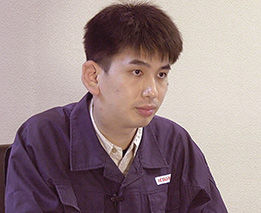Development background of ConSite OIL
There were various difficulties with conventional oil analyses. For examples, only experienced mechanics could take oil samples in a correct way and make a judgmental decision on whether good or bad. Also, oil analyses had to be accurate.
Researcher

Akira Kurasako
Research & Development Div. Advanced Development Center Component Group
Having accumulated and considered data piece by piece basis and put the oil sensor into production!
MR. Akira Kurasako
Component Group, Advanced Development Center, Research & Development Div.
Oil condition used to be judged by its color but such judgment could be done only by experienced experts and still different from expert to expert in many cases.
Also, oil sampling itself was time consuming and if it deviated a bit from set procedures, the accuracy of the analysis would be affected. In addition, due to tight job site schedules, oil sampling had to be done under a bad weather from time to time.
To resolve all these difficulties, I thought, “Wouldn’t it possible to automatically represent oil condition by numbers?” That was the start of this research. Not only in oil analysis but also in many areas visualization of physical quantities has been progressed. In a sense, visualization of oil condition fit the trend.
In the process of development of the oil sensor, we needed a lot of time to get and decipher data. It also to take us a lot of time and energy to install the sensors on actual machines and bench test units. However, the real bottleneck was to reproduce oil deterioration on these tests. That was because replacement intervals of our genuine hydraulic oil are 5,000 hours and that those for the engine oil are 500 hours. Therefore, it took us, at least, the same hours to evaluate the sensors in the research process, which was really a bottleneck. Also, in applying the sensors to actual machines, we had to develop an algorithm based on the accumulated and deciphered data. That was also a challenging task to us.
As a matter of fact, development of oil sensors was tried by other companies before but they could not put them into production. There have been also times when we thought we would give up the research. However, data from the sensors on actual machines gave us hope and could continue it. From data of the sensors on actual machines, we learned that we did not get expected results from the bench tests because of variation of data, inaccuracy of data and evaluation method of data. In monthly follow-up meetings, any negative opinion was voiced and every participant cooperated in a proactive way. That’s the real reason why we could put the sensor into production.
Planner

Kotaro Ogura
Assistant Manager
LCS Operations Div. Customer Support Div. Sales Promotion Dept.
The common challenges and requests of customers such as “We’d like to operate our machines with lowest possible costs for longest possible time.” and “We definitely want to avoid abrupt, unexpected downtime of machines.” initiated the development of “ConSite OIL.”
Researcher

Akira Kurasako
Research & Development Div. Advanced Development Center
Component Group
Oil condition judgment can be done only by experienced mechanics and still such judgment is different from mechanic by mechanic in many cases.

